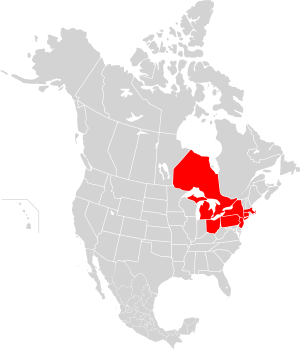 This image shows states and provinces that experienced power outages. Not all areas within these political boundaries were affected. | |
| Date | August 14–16, 2003 |
|---|---|
| Duration | 2 hours–4 days, depending on location |
| Location | Northeastern United States, Southeastern Canada |
| Type | Blackout |
| Cause | Failure of alarm system in FirstEnergy control room leading to cascading loss of transmission and generation capability. |
| Outcome | 55 million people affected |
| Deaths | Almost 100 |
The Northeast blackout of 2003 was a widespread power outage throughout parts of the Northeastern and Midwestern United States, and most parts of the Canadian province of Ontario on Thursday, August 14, 2003, beginning just after 4:10 p.m. EDT.[1]
Most places restored power by midnight (within 7 hours), some as early as 6 p.m. on August 14 (within 2 hours),[2] while the New York City Subway resumed limited services around 8 p.m.[2] Full power was restored to New York City and parts of Toronto on August 16.[3] At the time, it was the world's second most widespread blackout in history, after the 1999 Southern Brazil blackout.[4][5] The outage, which was much more widespread than the Northeast blackout of 1965, affected an estimated 55 million people, including 10 million people in southern and central Ontario and 45 million people in eight U.S. states.
The blackout's proximate cause was a software bug in the alarm system at the control room of FirstEnergy, which rendered operators unaware of the need to redistribute load after overloaded transmission lines drooped into foliage. What should have been a manageable local blackout cascaded into the collapse of much of the Northeast regional electricity distribution system.
- ^ "What Caused the Power Blackout To Spread So Widely and So Fast?" (Press release). Genscape. August 15, 2003. Archived from the original on May 18, 2016. Retrieved July 13, 2011 – via PR Newswire.
- ^ a b Cite error: The named reference
CNNwas invoked but never defined (see the help page). - ^ DGA Consulting, Australia (submitted to Australian Energy Market Commission) (May 5, 2016). International Comparison Major Blackouts and Restoration (PDF) (Report). pp. 16–17. Archived from the original (PDF) on March 13, 2018.
{{cite report}}:|author=has generic name (help) - ^ "2003: The great North America blackout". CBC News. Canadian Broadcasting Corporation. August 14, 2003. Archived from the original on August 15, 2015. Retrieved September 19, 2008.
- ^ "INDEPTH: Power Outage | Timeline". CBC News. Canadian Broadcasting Corporation. August 18, 2004. Archived from the original on February 3, 2013. Retrieved September 15, 2008.